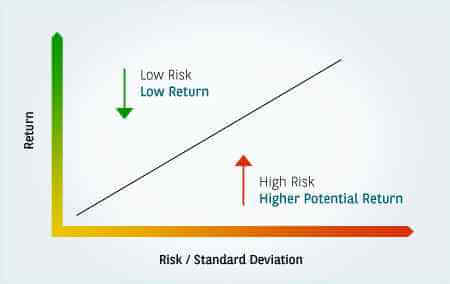Happy Investing!

The simplest way to define risk / return tradeoff is the "ability-to-sleep-well-at-night" test. Some investors handle financial risks better than others due to their current financial health, investment time horizon and realistic returns expectations.
'Risk' is the probability that the actual returns on your investments are different compared to your expectations. This is measured by standard deviation in statistics. Simply put, risk means that there is a probability of losing some, or even all, of your initial investment.
Deciding what amount of risk you are willing to take comfortably with your investments is extremely critical and will help you take crucial decisions while investing.
Risk/Return Tradeoff is all about achieving the fine balance between lowest possible risk and highest possible return. Low levels of risk are usually associated with low potential returns while higher levels of risk are normally expected to yield higher returns. The graph below depicts the typical risk / return relationship.

It is important to note that higher risk does not always mean higher returns. While the risk / return tradeoff indicates that higher risk gives us the probability of higher returns, there are no guarantees. Higher potential returns could also lead to higher potential losses.
The government securities represent the lower end of this risk / reward scale since their chances of default are almost zero. This represents risk-free return, which means, you can earn this rate of return virtually without any potential risk. But, earning 6% in a scenario where inflation is around 8% means that the value of your savings is steadily eroding. Traditionally, equity funds have given much more every year over the long term.
To earn this potential higher return from equities, you will have to take on higher risk on your investments. We call this excess return over the risk-free return as 'risk premium'.
Determining the appropriate risk level for you is not as simple as it sounds. Like most decisions on financial planning, your investment decision would depend on your goals, income, expenses, current savings etc. Many of us may not be able to tolerate the short-term market fluctuations. It is often said that risk tolerance has more to do with your stomach rather than with your head.
And, this is where 'Diversification' can come to your rescue.
Diversification is an effective risk management tool. It aims to mix a variety of instruments and asset classes in your portfolio to minimize the impact of any one asset class/ instrument on the overall performance of your portfolio. A well diversified portfolio has the ability to smoothen returns and reduce the overall risk that you carry.
To give you an example, let us assume that you are in a market where there are only 2 companies: one sells raincoats while the other sells leather shoes. If your entire portfolio consists of stocks of the company that sells raincoats, you will have strong performance during the monsoon, but the performance will suffer during summer. The reverse will happen for a portfolio consisting of stocks of the company selling leather shoes, since the sales of leather shoes is usually expected to substantially go down during the rains. But, if you had a portfolio with 50% each in both these stocks, you may be able to deliver consistent performance around the year, every year, instead of a cyclical trend depending on the season.
There are 3 broad ways to ensure that you achieve good diversification:
It is important to note that while diversification can go a long way in helping you guard against loss, it does not offer a guarantee against losses. No matter how much you diversify, investing involves taking on some risk.
Arriving at your risk taking ability and an ideal diversification plan is a highly personalised process and all of us need to customize it to suit our requirements. Seeking the help of a qualified financial planner may be a smart idea to achieve this.
Happy Investing!
It is mandatory for all mutual fund investors to undergo a one-time KYC (Know Your Customer) process. For more info on KYC specifically on: the procedure for completing KYC, for changing address details, for changing contact details.
For changing bank details, visit barodabnpparibasmf.in/investor-centre/information-on-kyc
For more info on submitting a complaint or a grievance, visit https://www.barodabnpparibasmf.in/contact-us
Further, investors should ensure that they transact ONLY with SEBI Registered Mutual Funds listed under Intermediaries/Market Infrastructure Institutions on the SEBI website https://www.sebi.gov.in/intermediaries.html
An Investor Awareness Initiative.
Mutual Fund investments are subject to market risks, read all scheme related documents carefully.